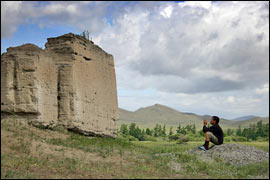|
 It was announced that a new centralized religious organization – General Buddhist Assembly, is being founded. This decision was made at the Founding Assembly, which took place at the Upper Chadan Buddhist complex “Ustuu-Khuree”. Representatives of leading local Buddhist organizations, monks and scholars – the followers of the former Kamby-Lama of the republic, Dzhambel Lodoy, who are in favor of the re-establishment of Kamby-Lama’s Pandido institute in Tuva, which existed during the times of Russian protectorate in Tuva. It was announced that a new centralized religious organization – General Buddhist Assembly, is being founded. This decision was made at the Founding Assembly, which took place at the Upper Chadan Buddhist complex “Ustuu-Khuree”. Representatives of leading local Buddhist organizations, monks and scholars – the followers of the former Kamby-Lama of the republic, Dzhambel Lodoy, who are in favor of the re-establishment of Kamby-Lama’s Pandido institute in Tuva, which existed during the times of Russian protectorate in Tuva. The declaration approved for this purpose states:”We consider that Tuvan Buddhism has, during this stage, reached qualitatively different level of its development, and it calls us all to the way of practice of Buddhist education and learning. We are filled with determination to realize His Holiness Dalai-Lama XIV’s address to the Tuvan people about the necessity of turning our attention to contemporary education, as well as to the study of traditional Buddhist philosophy. We aim to further affirm the faith in the Buddhist principle of compassion, in the human dignity and the value of human life, and to co-operate with the social progress of the community, by re-establishing Kamby-Lama’s Pandido institute, and continuing the spiritual activities of Lobsan Chamzy, by establishing a contemporary center of Buddhist education and learning on Tuvan land.”
The temple complex “Ustuu-Khuree”, which was the main Buddhist monastery and the residence of Pan-Tuvan Pandido of the Kamby-Lama Lobsan Chamzy, is to become such a center. He was elevated to the office of the head of lamaist clergy “over all the khoshuns of Uriangkhai region” by the Supreme Ruler of the Russian State, Kolchak, in 1919. After 11 years, Lobsan Chamzy was shot at the Adar-Tosh mountain pass.
Dzhambel Lodoy, who has already been elected for the post of the supreme hierarch of Tuva, announced that the newly born Kamby-Lama’s Pandido institute follows the teachings of the Gelugpa school. His residence – the reconstructed Ustuu-Khuree – will become a Buddhist, cultural, and educational center. Different directions will be represented – philosophical, iconographic, medical, astrological…
In his words, during the times of the protectorate, there were 32 monasteries in Tuva, and approximately 5 thousand monks, who lived there. However, these data do not take into account the nomadic, yurt khuruls. During these times, the khuree were the chief educational institutions. It was a strong, durable system. “According to history, Buddhism first came to Tuva by the way of the Silk Road in the IX Century, but it became widespread only much later, in the middle of the second millennium, through Mongolia and Tibet. During that time, in order to receive Buddhist learning and to become a monk, Tuvans did not spare their legs, wearing out several pairs of shoes, and risked their health going to Holy Tibet on foot. Our chief task today is to bring back those traditions.”
As far as the centralized administration of the Kamby-Lama of Tuva is concerned, it will, in the opinion of the founding assembly, most likely be discontinued.
Remember that this structure was established during the times so difficult for the country and for the republic – in 1997. Its chief functions, which involved unification of all the scattered Buddhist organizations and formations, have practically been fulfilled.
|
|
